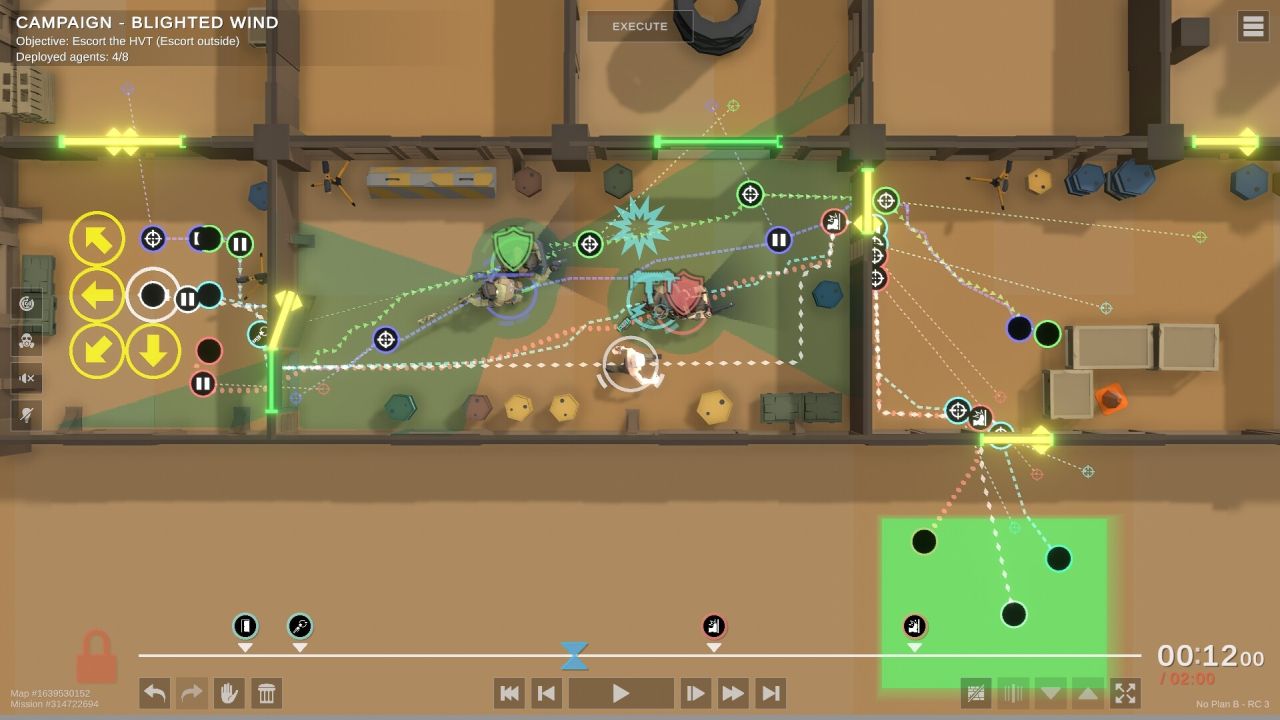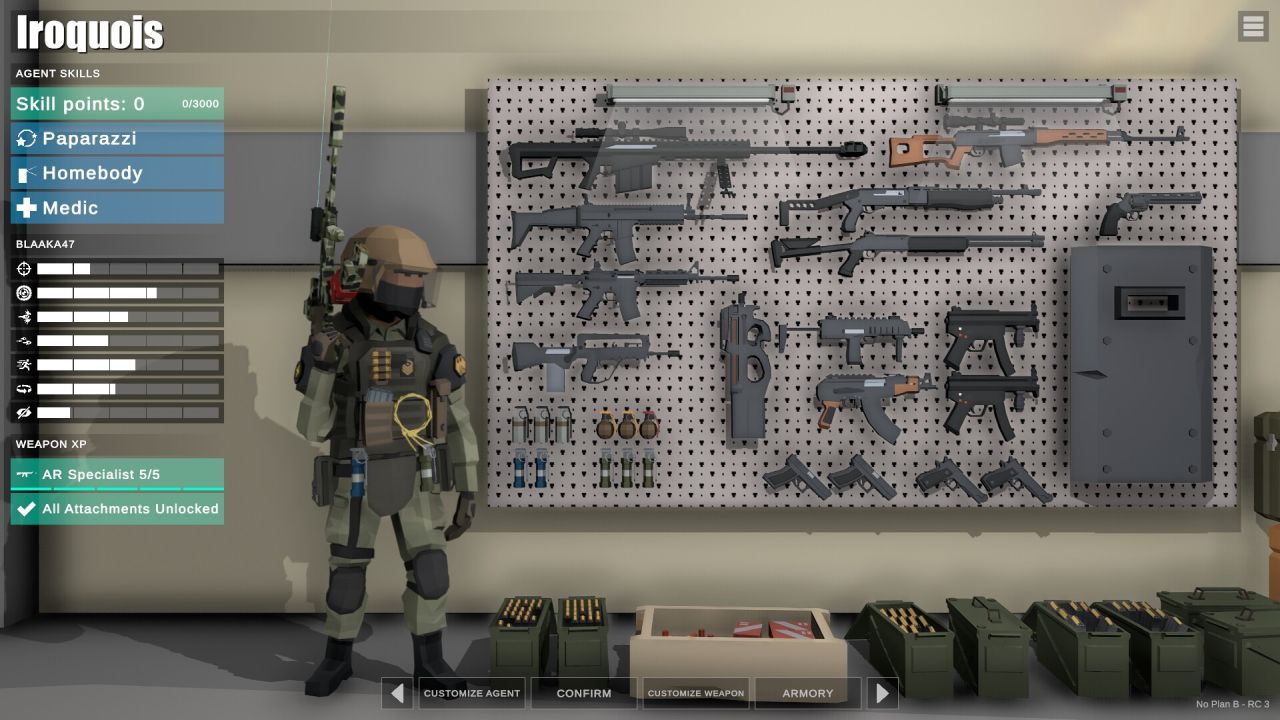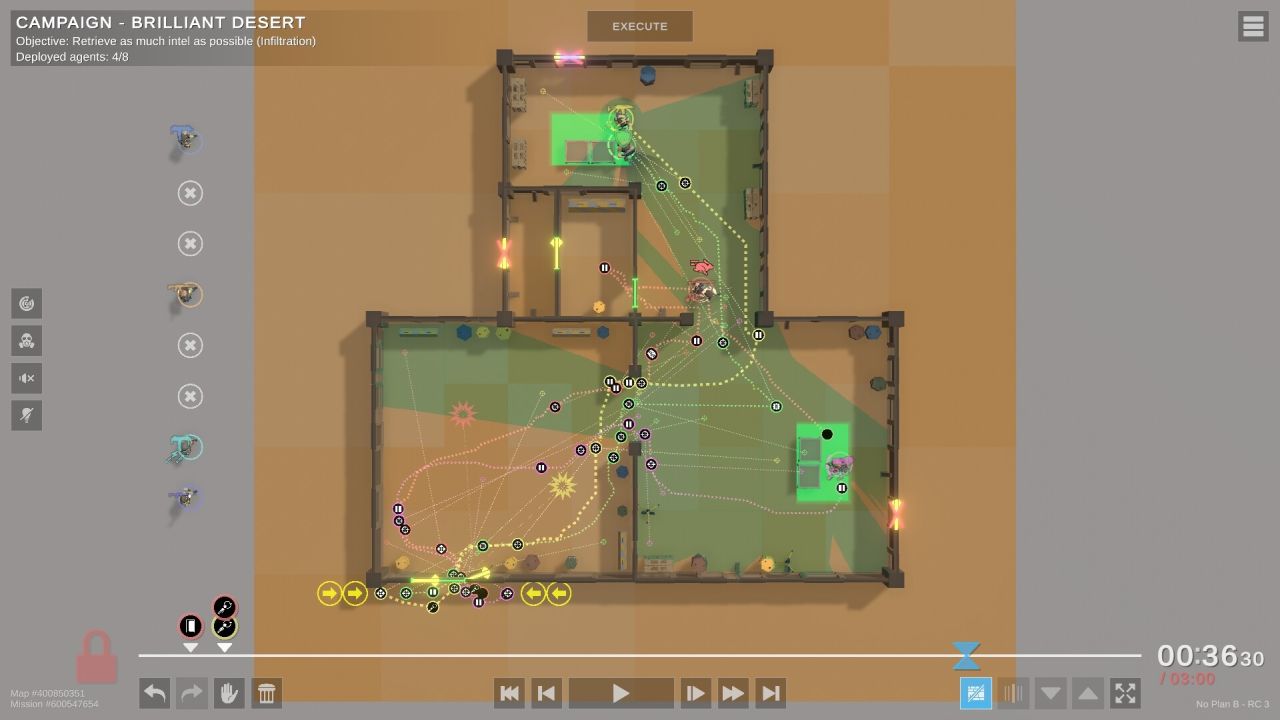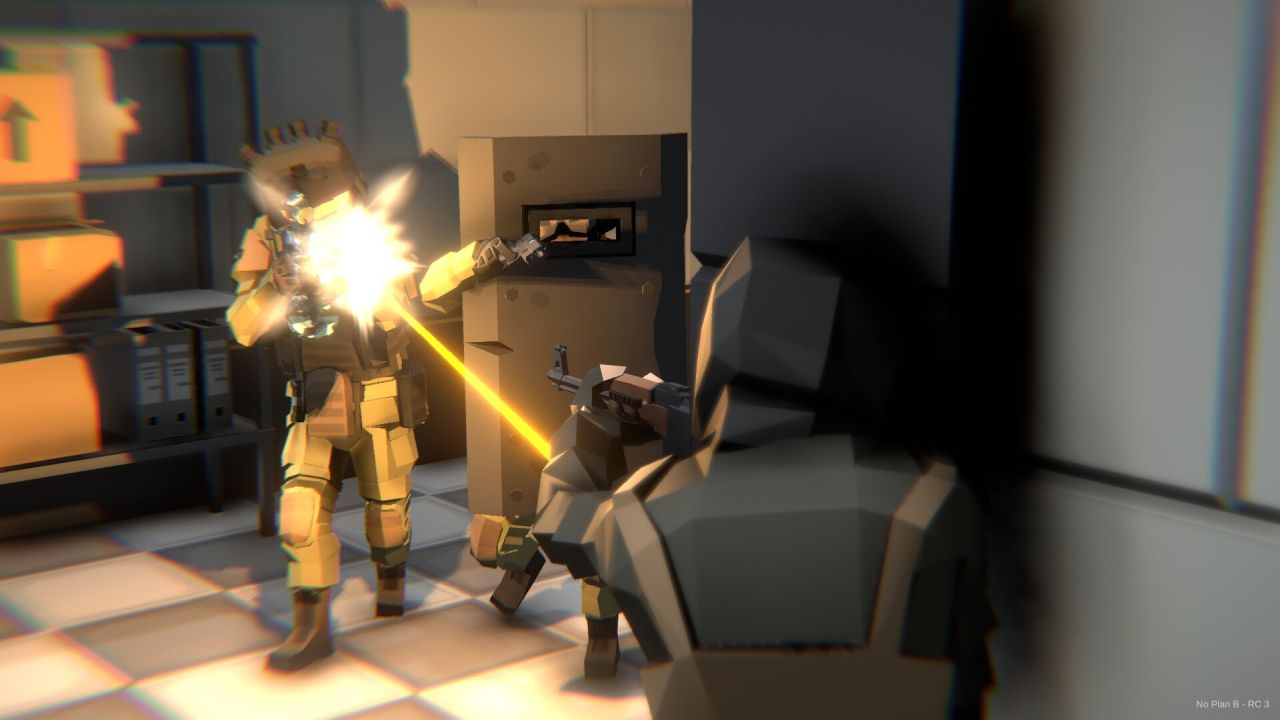No Plan B Review
Make a backup plan for your backup plan
Action games can be a hectic and stressful experience, especially those that put players into close-range scenarios. Having to carefully maneuver around interiors, in a high-stakes setting where bullets can eliminate you with just a few hits, can be both thrilling and taxing. Games such as military sims and titles like Ready or Not are well-versed in recreating such scenarios – but there are alternatives. Back in the day, Rainbow Six games let players create elaborate plans in a special mode and observe AI execute them. If you are looking to experience similar situations but from a safer distance, and are more interested in the tactics than the first-person thrills, the top-down strategy games such as Door Kickers and Frozen Synapse are an option. The latest entry in this tactical planning genre is No Plan B, which has a lot of similarities to others in the subgenre, but takes some getting used to and some of its design choices won't be for everyone.

No Plan B is a tactical close-quarters planning game where you draft plans for combatants from an overhead view, as they infiltrate a variety of locations to complete a few different objective types. Following a brief tutorial that teaches players the basics, the campaign mode offers a series of randomly generated missions, split into five chapters. You start off with a squad of just two special operatives, and must use them to clear about three missions in the first chapter. While it seems typical, the game provides a rough first impression. On default settings, you delve into the opening chapter with just two operatives and barebones equipment. Chances are high that you will fail at least one mission, and that's when you learn that the game's campaign is a rogue-lite. Failing any of the missions in a chapter means you have to restart the whole chapter, and replay all previous missions. Sure, the missions are all randomly generated and so you aren't exactly playing through the same thing twice, but it's still a source of immediate annoyance.
Another one of the game's frustrations is its lackluster UI and lack of explanations. While the basics of the gameplay are covered in the tutorial, you have to click around through the barebones and cheap-looking menus to find the other critical options available. Turns out, there is a difficulty setting, as well as lots of different modifiers available, such as starting off the campaign with a full squad of 8 members, permadeath, and so on. But these tweaks are hidden away in a menu screen that appears before you get into the main menu, and the tutorial skips this, so you may not find it until you start the game next time and find the squad editing screen.
Squad management is an important aspect of making it through the campaign and other modes, as it allows you to choose one of the four factions to play as, from SWAT to FBI, who have different visual styles and stats perks, such as increased health and faster aim. Again, this is something you have to discover on your own. With the chosen squad, you can outfit each member individually with different weapons. New weapons become available as you progress through the campaign, and include a variety of rifles, pistols, and shotguns. While each weapon has lots of detailed stats, just like in Ready or Not, you'd be hard-pressed to notice the difference in gameplay, except for between different weapon classes. You will also unlock lots of different attachments, as well as utilities such as grenades, that become quite important in difficult scenarios. Further, there are lots of visual customizations for your squad and their weaponry.
Delving into the campaign lets you experience the core of the No Plan B gameplay, which is similar to Frozen Synapse 2, but with a few unique aspects that crank up the difficulty. Players get an overhead overview of an interior of a building, and a few points of entry. You can choose to have your whole team enter at the same location, or from different areas. From there, you manually guide each member of the squad through the building, towards the objective if there is one, or just to clear every room. The central mechanic is the fact that all actions take place on a timeline. Kicking a door open, throwing a flashbang, moving through a room – this all takes real time and places actions on the timeline at the bottom of the screen. This then gives you the opportunity to select the next team member, and define what they are doing at the same time. As you scroll back and forth on the timeline, you can see exactly how the infiltration plays out in real-time, or step-by-step. This lets you create tactical entries and have each team member clear the room from different directions at the same time. This action synchronization is key to success. Your time on each map is also limited, so you do have to keep moving, but this is rarely a problem.

The major difference between No Plan B and other games in this subgenre is that you are planning the entire mission. While elsewhere, you are able to move through section by section and make decisions on the go, more akin to a turn-based game, here you are just setting a plan in motion and hoping it all works out. In this game, you are planning the whole thing without knowing that things will work out beyond the initial entry, and then deploying and watching the events play out. If there is a single hitch or unexpected outcome, the whole thing could be shot – and the campaign alongside it. It's certainly an interesting overarching design, but it pushes the game more and more into rogue-like territory, with forcible replays of the same scenarios over and over again, which many players may not find to be fun.
At your disposal are a few typical tricks, such as choosing to open or breach a door, throw a flashbang, crouch, run faster, and so on. Queuing up all these actions on the timeline takes some getting used to, as you can either manually drag / draw paths for your team on the map, or just point them where to go next. You can also manually select which direction they aim as they move, to provide better chance of clearing a room safely. The team will shoot at enemies they encounter, but having to turn around may be a costly mistake. Having your team take damage carries on to future missions, and if they are fully incapacitated, they have to miss the next mission to recover. That's assuming there is a next mission, if the remaining alive teammates can finish the tasks on their own. Characters also get assigned random personal perks as they level up.
Managing the actions of each team member and synchronizing them via the timeline is relatively easy, but does feel clunky and takes some getting used to. Clicking on specific events for other teammates, such as door opening or a flashbang exploding, synchronizes the time, so you can perform actions together. As your squad grows, the planning becomes more exhaustive, and quite micromanagement heavy. And because you have no way to dynamically respond to changing mission events, you are forced to just be extremely cautious and draw up exhaustive plans that account for all possible scenarios. But again, once you commit and hit play, there's nothing to do but watch and hope for the best. You can turn the tides in your favor by using special map abilities – such as doing a scan that can reveal enemy locations (which become more accurate with each subsequent use). Or you can turn off the lights or gas the place, which reduces enemy reaction time, but could affect your team as well if they lack the necessary equipment. The downside is that using these map abilities reduces your experience earned from the mission. It seems a small price to pay for getting everyone out – especially given some of the AI oddities that can occur.

As with most lower-priced games, the AI is quite basic, but because this is such a challenging title, that aspect stands out, just like it did in Ready or Not. Both friendly and enemy fighters mostly stand around and shoot at each other as soon as they can, and sometimes utilize cover. The game tries to introduce lots of variables, such as reaction time statistics and weapon statistics, but again it would be impossible to tell the difference between milliseconds of different aim stats on weapons. Instead, AI does silly things like flashbang a room while just standing in the doorway, open to enemy fire, and walk through a room without engaging the same enemy that their teammate just died to. As things get more complicated, with multi-storey structures, shields, grenades, and sniping positions, the challenge level keeps increasing. It again reinforces the need for extreme planning micromanagement, and constant hopes that the RNG works out in our favor.
The random element comes not just from the firefights, but also the maps. As mentioned, each map is randomly generated, with its layout, enemy placement, and objective locations. Missions can range from simply eliminating all hostiles, while trying not to shoot occasional civilians, to diffusing a bomb. The latter objective type means you have to guide a weaponless defuse character through the map to a specific point. The context of missions can change based on the selected faction, so you could become the bad guys and rob a bank instead – but the core aspects of the gameplay remain the same.
Outside of the campaign mode, you can delve into even more missions through Skirmishes, which are standalone infiltrations. There is also a Challenge mode with specific conditions, and missions that rotate on a daily/weekly basis where you can set scores and appear on leaderboards. There is even a survival mode, similar to the campaign except you get new bonuses after each mission and try to make it as far as possible, with permadeath enabled. Lastly, there is a map editor that lets you create custom mission maps and share them with others.
Visually, No Plan B is not overly impressive, but is sufficient for its tactical genre. As already mentioned, the menus and UI feel quite barebones and more like placeholders. The character designs and maps utilize the blocky low-poly art style, like you'd find in BattleBit. The overhead views where you spend most of your time are fine, but interiors often lack details. It doesn't look as good as Door Kickers 2, with the flat lighting and basic animations. The camera can be rotated just to give the maps some depth, and there is even a cinematic replay mode if you want to show off well-executed missions. Audio design is quite basic, with forgettable background music and rudimentary weapon effects.

No Plan B is an initially interesting but frequently frustrating tactical planning game. It borrows the same ideas that Frozen Synapse and Door Kickers have delivered on, but makes the missions all-or-nothing. Having to plan the entire infiltration and then sit back and watch with hope and a prayer that things will work out is a unique approach, but it doesn’t make for exciting gameplay. Mixing the high level of tactical operations with the fact that everything must be pre-planned and you are helpless when it comes time to execute makes for more frustrating moments than anything else. It's undoubtedly a very well-rounded game in terms of features and content – with randomly generated maps, lots of modes, plenty of squad customization, and so on. But with the core gameplay carrying so much inherent frustration, combined with lackluster AI and underwhelming presentation, even at $15 asking price, this title will only appeal to a very specific group of players.
 Comments
Comments
















